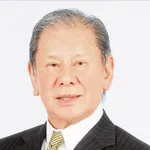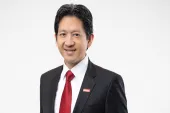
UCPB: Moving forward amid legal debacles
Perhaps a drive through Manila’s main thoroughfares would make one realize that Philippine banks have changed – quite literally, that is – what with the newly refurbished branches and fresh renditions of names and logos aimed at luring more customers.
The United Coconut Planters Bank (UCPB) is not an exception to the trend, with its recent rebranding probably among the most striking among Philippine banks that have embarked on the same exercise just before the global financial crisis erupted.
But UCPB’s new look is a mere icing on the cake, as this is just a signal that the bank is moving forward after years of slump brought about by a 23-year-old legal squabble that has weighed down on its growth.
More than fresh looks
UCPB’s new look signaled its departure from its identity as the Cocobank — as it was loosely refered to — which catered mainly to coconut farmers in the 1970s. It now serves a wider market made up of the middle market, small- and medium-scale enterprises, retail customers, and a small slice of the corporate market.
Its new corporate colors consisting of four shades of blue show a complete turnaround from its previous blue-green-gold identity.
Its signage now sports plain, clean and simple rendition of its name and an infinity symbol for a logo, a change from the stylized “UCPB” of yore, signifying that it has joined the ranks of its larger counterparts in terms of capability to service the changing needs of the banking public.
“The infinity also signifies that the bank and the customer are holding hands. It means we are here to serve anyone,” Sy said.
But the fresh look, for Sy, is but part of a bigger step that the bank is doing to help it keep moving forward amid a two-decade-long court battle whose end remains uncertain.
The bank’s troubled past traces decades of history, starting from its appointment by the late dictater Ferdinand E. Marcos as the depository bank of levies collected from coconut farmers in 1975.
UCPB was then among the highest capitalized banks in the country, with a scale that enabled it to become a trailblazer in various aspects such as technology for being among the first ones to roll out automated teller machine (ATM) services in the 1980s.
It is also among the first few commercial banks to have been given a universal banking license, which allowed it to engage in non-allied undertakings such as insurance and pre-need.
When martial law ended with the assumption of President Corazon C. Aquino to power in 1986, the Presidential Commission on Good Governance (PCGG) — a government agency tasked to recover the ill-gotten wealth of the Marcoses —has sequestered 95% of the bank.
From thereon, the bank’s profitability dwindled, overshadowing its reputation as among the better-capitalized lenders in the country.
The bank regained its strength when Sy took over the helm of the bank. But when he left in 1992 to lead what was then International Exchange Bank (iBank), bad management decisions and the impact of the 1997 Asian financial crisis have led to billions in losses.
It then faced more troubles when the Supreme Court ruled in 2000 that businessman Eduardo Cojuangco, Jr. used public funds for the purchase of the bank’s shares, prompting the PCGG to take over the board of the bank.
This led to massive withdrawals by depositors, which in effect restricted the bank’s capability to lend.
The ownership dispute, on the other hand, has disallowed the bank from raising capital either by having its shares listed at the local bourse or issuing lower Tier 2 debt notes, rendering it incapable of raising its capital adequacy ratio — or its financial strength in relation to the risks that it takes — to the 10% minimum required by the central bank.
In 2003, the Philippine Deposit Insurance Corporation (PDIC) came to the rescue by extending a P20-billion financial assistance to the bank.
Of the amount, P8 billion was used to buy the bank’s soured loans at face value, enabling it to recover P7 billion in loan loss provisions.
The remaining P12 billion was converted into Tier 1 or core capital earlier this year.
On top of the PDIC assistance, UCPB has also inked an agreement in July 2008 with the Philippine Department of Finance, the PDIC and the Bangko Sentral ng Pilipinas for the provision of P30 billion in deposits by the national government.
The amount was meant to be placed in government securities, which should provide a boost to the bank’s investment income.
The government takeover and the infusion of funds entitled the state deposit insurer to eight board seats, while the Finance department has four.
The bailout packages have so far served their purpose as UCPB was able to book P1.1 billion in net income in the nine months to September, a big turnaround from losses of P1.4 billion in the same period in 2008.
The improvement in its profitability as of the third quarter was helped by 69% growth in interest income loans and investments, as well as 180% increase in non-interest income due to better treasury operations and sale of non-performing assets.
The bank also remained as the 12th largest lender in the Philippines with assets totaling to P157.18 billion as of end-September.
Despite limited help from the government and legal woes at its back, the bank had no choice but to move forward, especially in the context of the Philippine banking landscape where competition is cutthroat.
“Unfortunately in this country, anything that ends up in court stays for a long, long time, especially a complicated, politically-charged issue such as sequestration and ill-gotten wealth. It is very unfortunate,” Sy said, who returned to UCPB in 2007 after his stint at iBank.
iBank has merged with Aboitiz-led Union Bank of the Philippines in 2006, with the latter as the surviving entity.
“But we have decided that we have to change if we are to survive. And we have to capitalize on the strength, and that is our brand of service. Our customers stayed with us because of the quality of service we provide. There are larger banks with larger networks with more products to offer. Given the problems that we have, we are able to compete all these years,” he added.
Sy said that aside from the change in corporate identity, the bank has also set aside over P1 billion for renovation of its branches.
The bank is also updating its automation system by spending about P1.4 billion in the next three to four years, he said.
“We have to automate because we have fallen behind. We have not been able to update our systems for many years. We have to leapfrog,” Sy said, adding that better automation system would allow the bank to offer more products.
But more importantly, for the bank president, keeping up with the competition will require a lot of training for its 2,000-strong workforce.
“The visuals obviously attract attention. It is a way of informing the general public that we are doing something different more than what we have been doing in the past,” he said.
“In a way the term rebranding is a misnomer because people associate it with just the visuals. At least to us, it is much more than that; it involves our people.”
Sy said its rebranding would entail a change in the bank’s processes from the top level down to the rank and file employees. Processes in branches, and even compensation and incentives to its employees will also be changed while retaining its own brand of service.
He did not provide precise figures for its allocation for training of its personnel given that the endeavor is a “continuing process” that will stay on with the bank, he said.
“As we develop products and hire new people, we have to keep on reminding our people of who we are and what we are here for,” he said.
Next chapter
Sy also said that while the bank is constrained by legal impediments to raise capital, it will find ways to do so to continue fueling its growth momentum.
He said the bank needs to expand its branch network to as much as 350 in the next three to four years, depending on how much authority it can obtain from the central bank.
Currently, the bank has 178 branches while UCPB Savings, its thrift bank subsidiary, has 33.
Sy said expanding its network would enable it to compete with the larger banks.
Officials of the PDIC are also mulling on their exit strategy as they expect to get back the P12-billion loan that it extended to the bank once the high court decides with finality who the true owners of the bank are.
Asked on his outlook on the court case, Sy said: “I hope the sequestration issue can be resolved soon. It’s been 23 years and it is a long time. The case is not in our hands. Our job here is to just run the bank, manage it, and keep it growing.”
Regardless of who will be declared the true owners of the bank, UCPB has, at the very least, prepared for something big.


















 Advertise
Advertise










